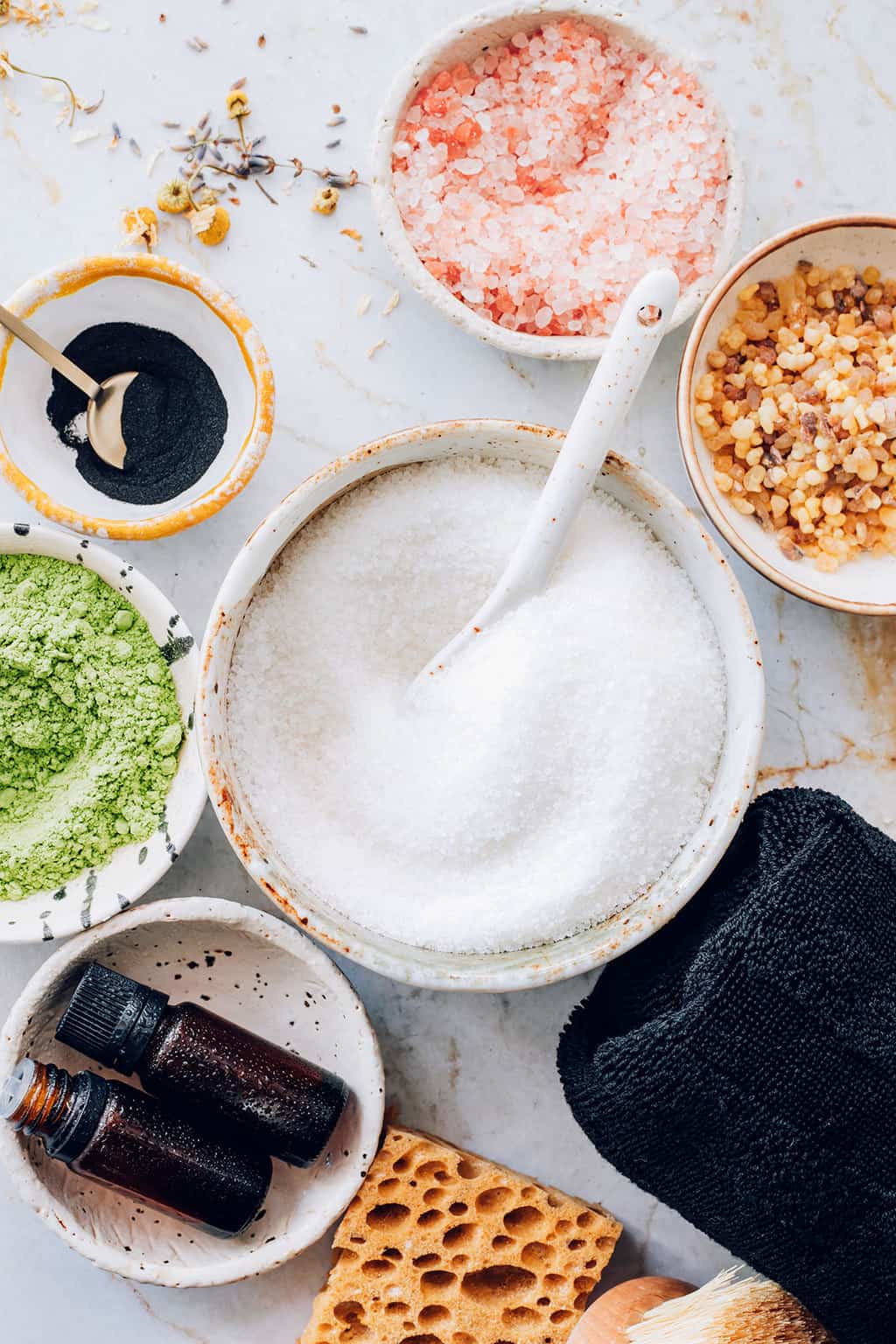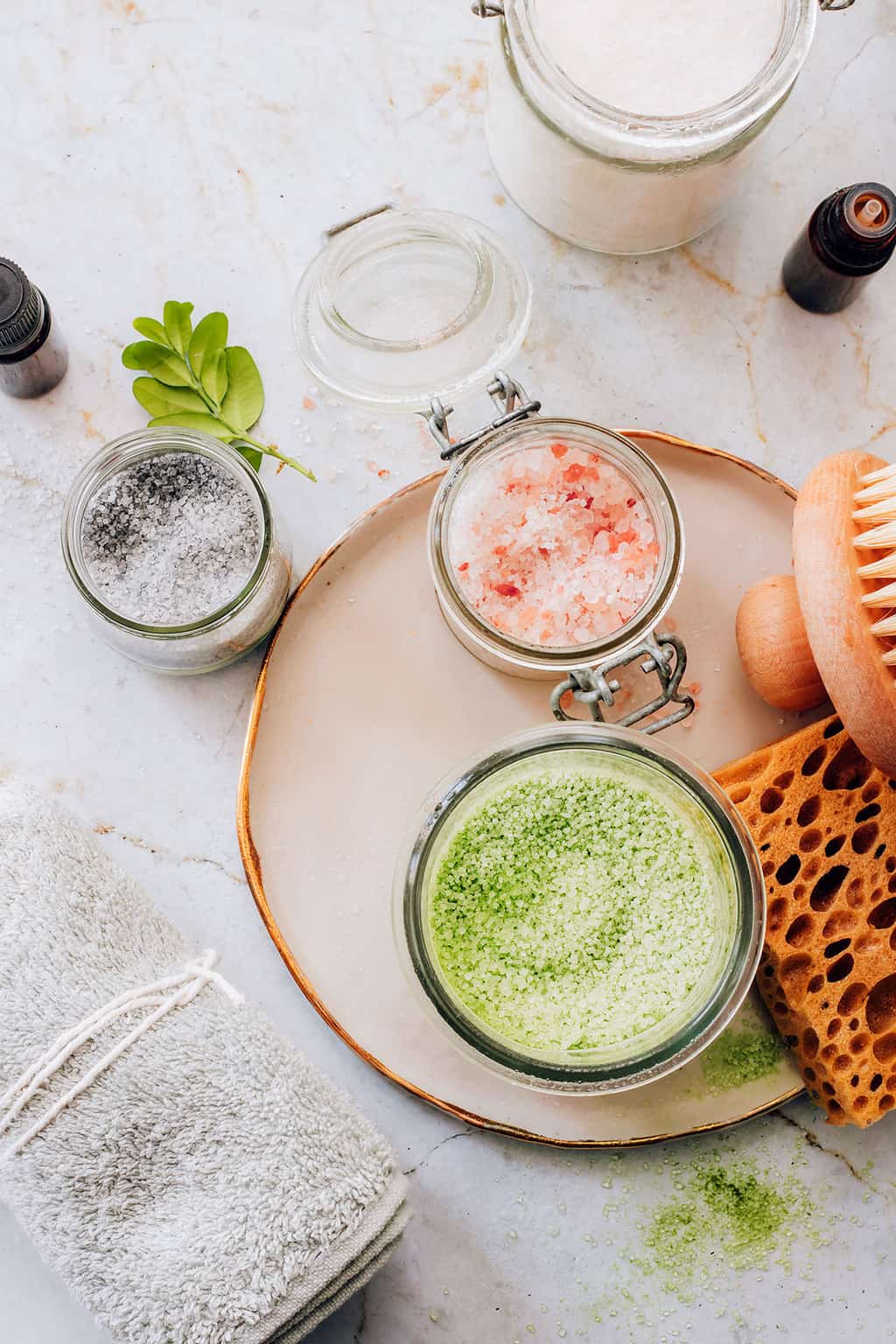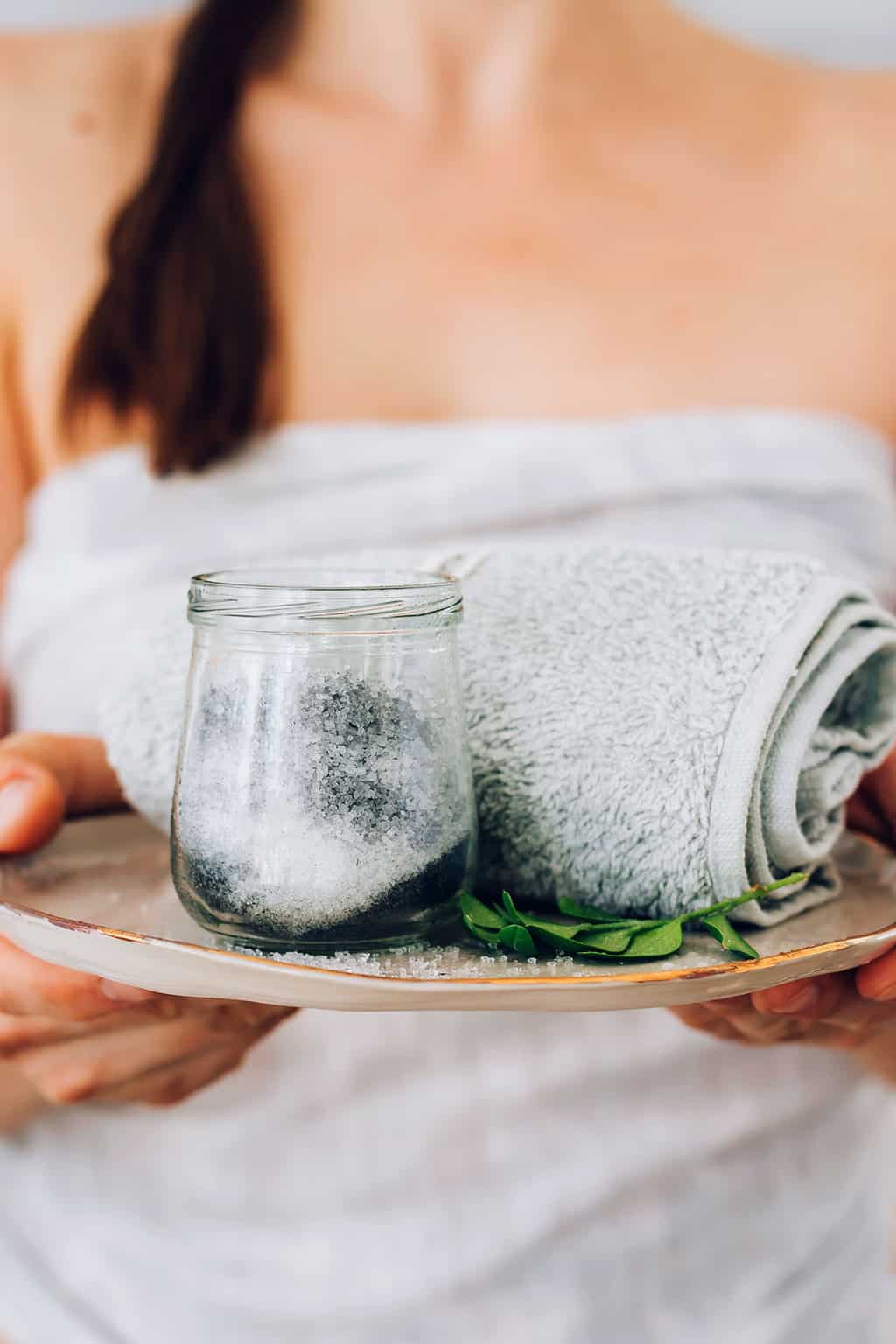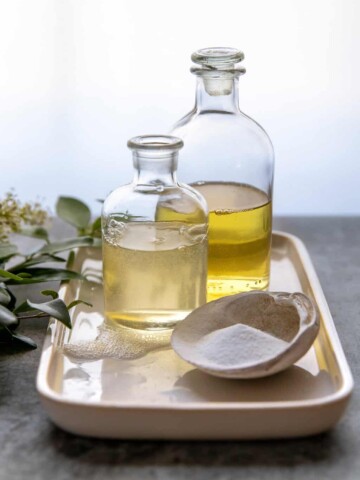People often ask me how to get started with DIY beauty, and my answer is always the same: take an Epsom salt bath. Buy a big bag of unscented Epsom salt (I get this 20-pound one!) and dump a cup or two into a warm bath.
Add a big scoop of coconut oil if you like—take care when you step in and out as the tub will be slippery! Soak for half an hour, and you'll get out feeling soft and oily and ready to fall right to sleep.
Why am I such an Epsom salt evangelist? Because this inexpensive natural remedy has numerous health benefits and helps so many ailments. Whether you're sore, can't sleep, stressed out, or having cramps, an Epsom salt bath is the way to go. Epsom salt baths are my go-to for kids who might be getting sick or won't stop scratching bug bites.
9 Reasons To Take An Epsom Salt Bath
Here are 9 reasons why you should soak up all of the Epsom salt bath benefits and 11 relaxing bath soaks that will not only leave your skin radiant and glowing but also improve your health.
Epsom salt boosts magnesium levels.
Epsom salt is not really salt like table salt. It's actually made of magnesium sulfate, a mineral that helps your body relax and impacts more than 300 enzyme systems. And many people are magnesium deficient, which can cause a whole host of problems, like anxiety, PMS, migraines, muscle aches, and high blood pressure [source]. And if you're stressed or consume caffeine, salt, or alcohol, your magnesium levels could probably use a boost.
I'm a fan of magnesium-rich foods like leafy greens and beans, but I'm an even bigger fan of soaking in the tub. Unfortunately, with current farming practices, most of our soil has become deficient in magnesium. So even if you are eating plenty of leafy greens, you are likely deficient unless you are growing them yourself or buying them at local farmers’ markets. Those soaks work because magnesium can be absorbed through the skin [source], so an Epsom salt bath is an easy way to restore your body's magnesium levels. That's a win-win.
Epsom salt helps you de-stress.
Stress and magnesium are interrelated. Stress depletes the body of magnesium [source]. And anxiety and depression are often present when there's a magnesium deficiency [source]. You need magnesium to deal with stress, but then stress lowers magnesium levels.
When you're stressed, your body is constantly pumping out adrenaline. Magnesium helps regulate those hormone levels while boosting the production of serotonin, the “feel good” hormone [source]. The magnesium in Epsom salt relaxes the body and mind by activating the parasympathetic nervous system, the part of the nervous system that creates feelings of calm.
Epsom salt eases muscle aches and pains.
One of the reasons your muscles ache is because lactic acid builds up in the tissues. Adequate magnesium levels help prevent lactic acid from accumulating by clearing it out faster [source]. Epsom salt also draws excess fluid out of the body, and lactic acid generally gets cleared out with the fluid.
Epsom salt also relieves pain and inflammation, so a long soak is a good prescription for ailments like stomach cramps and headaches. And it can also help ease migraines.
Epsom salt reduces swelling.
Your skin soaks in all the anti-inflammatory Epsom salt bath benefits. The salt can shrink tissues, which is especially helpful in reducing the painful swelling of sprains and bruises. Inflammatory skin diseases like eczema and psoriasis also respond to Epsom salt baths.
Epsom salt helps insomnia.
Magnesium calms the body and the mind, and lowering stress and anxiety can help you fall asleep. It plays other roles in sleep, too. One side effect of magnesium deficiency is insomnia [source]. Boosting magnesium levels can help you fall asleep, reduce night awakenings, and improve sleep quality [source].
Epsom salt cleans and softens.
A mineral-rich bath soak will soften and smooth dry skin. To up the cleansing effects, massage the Epsom salt granules into your skin while you bathe to exfoliate dead skin cells. After the salt has dissolved (the granules are too rough for delicate skin), you can massage it into your face to break up blackheads and draw them out of your pores. Avoid contact with your eyes, of course.
Epsom salt helps your body detox.
Epsom salt makes a simple but effective detox bath. The sulfates help flush toxins and heavy metals from your cells. And soaking in the mineral-rich water triggers reverse osmosis in your pores, so salt is pulled out of your body and the yucky toxins along with it.
Epsom salt draws out splinters and stings.
Epsom salt is a good first line of defense for bug bites, splinters, or small cuts that start looking red. A long soak draws out toxins and brings splinters to the surface, and magnesium’s anti-inflammatory effects soothe red, irritated skin.
Epsom salt improves energy.
Magnesium is an essential part of energy metabolism and muscle function. Studies on animals indicate magnesium can improve exercise performance [source]. Conversely, human studies show magnesium deficiency impairs exercise performance [source].
11 Epsom Salt Soak Recipes
Add 2 cups of Epsom salt to the water in a standard-sized bathtub (double for larger-sized tubs). Soak for at least 20 minutes, three times weekly.
For an extra treat, add dried herbs or vanilla or one of these essential oil bath salt combinations for a soothing scent. There's no doubt a bath soak provides a mental treat, but it also eases sore muscle pain and can help with insomnia.
Read on for 11 more Epsom salt soak ideas!
1. Basic Epsom Salt Soak Recipe
- 2 cups Epsom salt
- 1 cup kosher or sea salt
- ½ cup baking soda
Combine the dry ingredients. Pour 2 cups of the mixture under warm, running bath water, and soak for 20 minutes.
2. Restoring Salt Soak with Pink Himalayan Salt
Use mineral-rich pink Himalayan salt to revitalize tired muscles and help replenish the minerals your body needs. Uplifting bergamot and frankincense essential oils promote balance and help provide relief from stress.
- 2 cups Epsom salt
- 1 cup pink Himalayan salt
- ½ cup baking soda
- 2 tablespoons carrier oil, like jojoba, almond, or grapeseed oil
- 10 drops bergamot FCF essential oil
- 10 drops frankincense essential oil
Combine the essential oils with the carrier oil, and stir into the remaining dry ingredients. Pour 1–2 cups of the mixture under warm, running bath water and soak for 20 minutes.
3. Moisturizing Salt Soak with Shea Butter
A soothing soak that incorporates shea butter and almond oil to help ease sore, achy muscles while moisturizing the skin. This extra-rich silky formula has added natural essential oils, known for their ability to help soothe the senses and clear the mind.
- 2 cups Epsom salt
- 1 cup kosher or sea salt
- 2 tablespoons sweet almond oil
- 2 tablespoons shea butter
- 5 drops bergamot FCF essential oil
- 5 drops clary sage essential oil
- 4 drops ylang ylang essential oil
- 4 drops geranium essential oil
Melt shea butter and add the essential oils and sweet almond oil off the heat. Add in the salts and stir. Spread the mixture onto a cookie sheet to dry for 12–24 hours. When ready to use, pour 1–2 cups of the bath salts under warm, running bath water and soak for 20 minutes. Take care when stepping out of the tub, as it may be slippery.
4. Balancing Salt Soak with Matcha Green Tea
Add the power of antioxidant-rich matcha green tea [source] to your next relaxing bath. This calming soak combines Epsom salt with matcha to encourage calm and focus, while a soothing blend of chamomile and sandalwood essential oils refreshes the spirits and promotes restful sleep.
- 2 cups Epsom salt
- 1 cup sea salt
- ½ cup baking soda
- 1 tablespoon matcha powder
- 2 tablespoons carrier oil, like jojoba, almond, or grapeseed oil
- 10 drops Roman chamomile essential oil
- 5 drops geranium essential oil
- 5 drops sandalwood essential oil
- 5 drops lemon essential oil
Combine essential oils with the carrier oil, and stir into the remaining dry ingredients. When ready to use, pour 1–2 cups of the bath salt mixture under warm, running bath water and soak for 20 minutes.
5. Relaxing Salt Soak with Lavender
Combine Epsom salt with lavender essential oil, which has soothing properties [source] known to promote a better night’s sleep.
- 2 cups Epsom salt
- 1 cup sea salt
- ½ cup baking soda
- 2 tablespoons carrier oil, like jojoba, almond, or grapeseed oil
- 20 drops lavender essential oil
Combine the essential oil with your carrier oil of choice, and stir into the remaining ingredients. When ready to use, pour 1–2 cups of the mixture under warm, running bath water and soak for 20 minutes.
6. Cooling Salt Soak with Eucalyptus & Mint
A cooling soak to help you breathe easy, restore the body, and clear the mind.
- 2 cups Epsom salt
- 1 cup sea salt
- ½ cup baking soda
- 2 tablespoons carrier oil, like jojoba, almond, or grapeseed oil
- 10 drops spearmint essential oil
- 4 drops rosemary essential oil
- 4 drops eucalyptus radiata essential oil
Combine the essential oils with your carrier oil of choice, and stir into the remaining ingredients. When ready to use, pour 1–2 cups of bath salts under warm, running bath water and soak for 20 minutes.
7. Cleansing Soak with Activated Charcoal & Black Lava Salt
Purifying activated charcoal and black lava salt help cleanse the body of its impurities [source] and revitalize the skin. A blend of juniper and grapefruit essential oils helps refresh the skin and ease fatigue.
- 2 cups Epsom salt
- 1 cup black lava sea salt
- ½ cup activated charcoal
- 2 tablespoons carrier oil, like jojoba, almond, or grapeseed oil
- 10 drops grapefruit essential oil
- 5 drops juniper essential oil
Combine the essential oils with your chosen carrier oil, and stir into the dry ingredients. When ready to use, pour 1–2 cups of bath salts under warm, running bath water and soak for 20 minutes.
8. Purifying Salt Soak with Deep Marine Sea Kelp
A purifying soak that blends Epsom salt, sea salt, and sea kelp helps to ease muscle soreness. Lemongrass and orange essential oils create a blissful aroma to relax the muscles as well as the mind.
- 2 cups Epsom salt
- 1 cup sea salt
- ½ cup sea kelp powder
- 2 tablespoons carrier oil, like jojoba, almond, or grapeseed oil
- 10 drops sweet orange essential oil
- 5 drops lemongrass essential oil
Combine the essential oils with your chosen carrier oil, and stir into the dry ingredients. When ready for your bath, pour 1–2 cups of bath salts under warm, running bath water and soak for 20 minutes.
9. Energizing Salt Soak with Ginger & Clay
Ginger and clay help to cleanse away your body’s impurities while helping you feel more energized.
- 2 cups Epsom salt
- 1 cup sea salt
- ½ cup Bentonite clay
- 2 tablespoons carrier oil, like jojoba, almond, or grapeseed oil
- 4 drops ginger root essential oil
- 6 drops black pepper essential oil
- 8 drops cardamom essential oil
- 2 drops cedarwood atlas essential oil
Combine the essential oils with your carrier oil of choice, and stir into the dry ingredients. When ready for your bath, pour 1–2 cups of bath salts under warm, running bath water and soak for 20 minutes.
10. Nourishing Salt Soak with Milk & Honey
A nourishing soak that reduces the inflammation of itchy skin while it softens and hydrates.
- 2 cups Epsom salt
- 1 cup sea salt
- ½ cup whole milk powder
- ½ cup honey powder
Combine the dry ingredients. Pour 1–2 cups of the mixture under warm, running bath water, and soak for 20 minutes.
11. Calming Salt Soak with Chamomile
Soothing and calming German and Roman chamomile essential oils create a relaxing bath soak for your whole body.
- 2 cups Epsom salt
- 1 cup sea salt
- ½ cup baking soda
- 2 tablespoons carrier oil, like jojoba, almond, or grapeseed oil
- 6 drops Roman chamomile essential oil
- 6 drops German chamomile essential oil
- 5 drops lavender essential oil
- 3 drops clary sage essential oil
Combine essential oils with your favorite carrier oil, and stir into the dry ingredients. When it’s time for your bath, pour 1–2 cups of bath salts under warm, running bath water and soak for 20 minutes.
More easy (and inexpensive) Epsom salt ideas:
Glowing skin exfoliating treatment: Mix 2 cups of Epsom salt with ¼ cup of coconut oil and a few drops of lavender essential oil. Use the mixture to gently scrub away dry skin patches. Note: NOT for use on the face.
Pedicure perfection: Dissolve a half cup of Epsom salt into 2 quarts of warm water. Pour the water into a container, and soak your bare feet for 15 to 20 minutes. For an extra treat, add a few drops of eucalyptus essential oil for a refreshing scent.
Massage the entire foot with Epsom salt, concentrating on the heels and ankles to remove any dry, rough spots. Then, rinse your feet off with clean tap water and dry them thoroughly.
Homemade bath crystals: Mix 2 cups of Epsom salt with a few drops of fragrance to create a custom bath crystal. Add a few drops of food coloring or ½ teaspoon of glycerin if you like. Store in an air-tight container.
This post was medically reviewed by Dr. Jennifer Haley, a board-certified dermatologist with extensive experience in medical, cosmetic, and surgical dermatology. Learn more about Hello Glow’s medical reviewers here. As always, this is not personal medical advice, and we recommend that you talk with your doctor.
Photos by Ana-Maria Stanciu
150








Leave a Comment